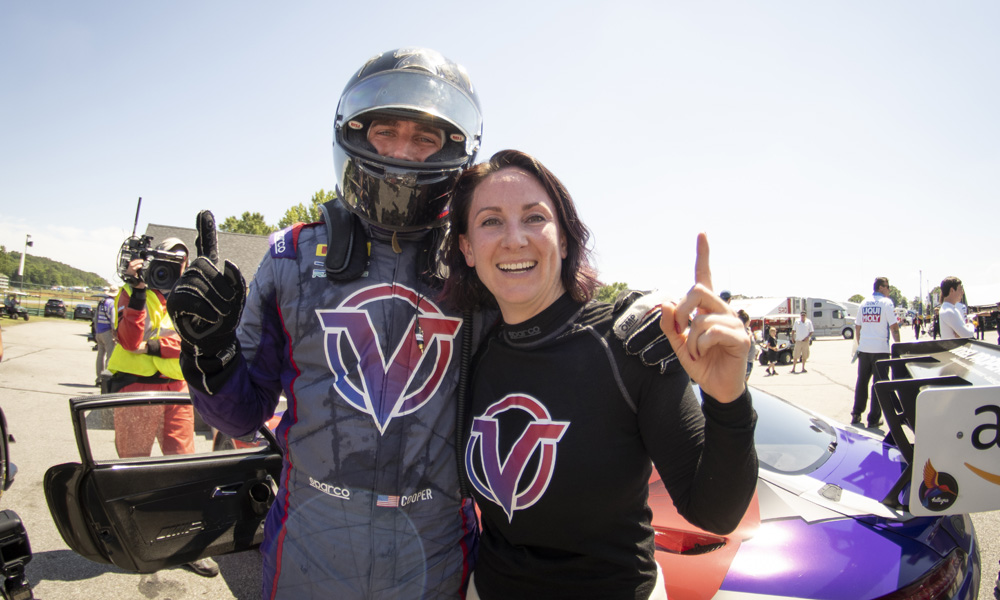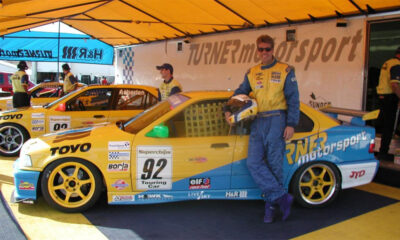
Photo: Brian Cleary/SRO America
Erin Vogel earned her first career Fanatec GT World Challenge America powered by AWS class win in Race 1 at VIR and in so doing became the first female driver to win a GT3 race in SRO America history.
This week in the Pirelli Paddock Pass, Vogel discusses the significance of the win, how her DXDT Racing teammate Michael Cooper has helped her hone her skills, the transition from GT4 to GT3, and more.
What was the significance of achieving your first win in Fanatec GT World Challenge America powered by AWS?
“I think mostly the win was surprising and it was exciting because of how great it made the whole team feel. It really came down to a whole team effort, as it often does in racing.
“It was really great to see them all feel so rewarded for the hard work they’ve been putting in. For me personally, it was really exciting because VIR is one of my favorite tracks.
“It’s a place where last year I felt like I really started to ‘get it’ as a driver working with Michael. It was also the first place that we had really major car trouble with the GT4 car and it started that snowball of us just not ever being able to get that car to be what it should have been last year.
“It was very cool to get a win there after last season. I really have to give credit to everybody from the team and to Michael for all of his great coaching.”
What has Michael Cooper brought to you and your program since you began working together?
“So many things. He’s really, really good in the data. When I started working with him I knew that data was something that I needed to start doing, but I didn’t understand how to do it properly.
“I didn’t know really what I was even looking at. He has helped me understand the data in a huge way. It’s been so valuable because it is concrete.
“Prior to that I’d have people say, ‘You should try this,’ or ‘You should try that,’ but when you look at the data it’s right there: I thought I was doing this but I’m not doing this.
“It makes it some much easier, so much more clear-cut and straightforward. Beyond that, working with a pro driver you get a glimpse into their lifestyle and you understand the discipline that it takes.
“You just have a better idea of what the tools are to perform at a higher level which was something that I really wanted to do. I don’t think I really understood how much I would get from that aspect of the relationship.
“Maybe not everybody does with every pro driver that they work with, but Michael has been very generous in sharing all of that and helping me try to become the whole picture and not just showing up to the race track to try to have fun but focus in between events on what will help me grow as an athlete.”
Are there one or two specific things that were eye-opening about a professional driver’s approach?
“Yes, a couple of things. He doesn’t drink which I think helped me a lot.
“I thought I’d try that two years ago after working with him for about a year and it’s really helped me be a little more focused with things and take more advantage of the time that I have in my day. That’s been a big one.
“And then having someone who can be a sounding board when I’m stuck on something in my training.
“I have a lot of friends that are into different types of training but if the goal is not the same sometimes it’s harder to relate. With the same goal it’s been really great because it’s been more targeted.”
What have you had to adapt to most in your transition from GT4 last year to GT3?
“The fact that the car is on the limit so much more, and on the limit so much more of the time, there’s less room for error. On the other hand it’s such a capable platform compared to the GT4 with all of the aero.
“It helps you get to that point where you’re on the limit which you’re flirting with in the GT4 but it’s just different. On the one hand that makes it a far more pleasant experience because it’s almost like the car talks to you more.
“You get better feedback from the car, but at the same time you have to be that much more precise. I haven’t struggled with the transition as much as I thought but I think it’s because we worked hard on preparing for it.
“I think if I had just jumped into it it would have been a really big shock to the system but the way we did it I think it helped the transition.”
What is the significance to you of earning the first GT3 win for a female driver in SRO America history?
“On the one hand I try to work hard within the team to not be different or act like I should be treated differently, but at the same time I recognize that there still needs to be discussion about that.
“We need to honor the fact that we haven’t gotten as much recognition as equals in certain fields as women. It’s been changing but I think it’s still important to recognize that change is happening. It’s a combination of the two outlooks.
“It was one of the goals when I started racing to be able to do well not just for myself but to try to be a role model or to be visible to show that we’re out here doing this too and we’re equally capable.
“There’s been so much positive feedback and people thanking me which has been really cool.
“It’s exactly the kind of result that I wanted when I started doing this: to make other people feel a sense of pride in themselves and the work that they, do whatever industry or field that that’s in, to make them feel like it’s inspiring them in some way. It’s been really cool.”
























